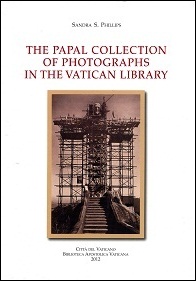
The San Francisco Museum of Modern Art (SFMOMA), in cooperation with the Vatican Library, is pleased to announce the publication of a book on the previously unknown and major collection of photographs at the Vatican Library. Authored by SFMOMA’s Senior Curator of Photography Sandra S. Phillips, The Papal Collection of Photographs in the Vatican Library provides the first public look into this extraordinary collection. The book studies and reproduces over 100 photographs, and focuses on the period of the mid-19th to early 20th century, ending with pictures made around the time of World War II.
“This is a wonderful collection, one that was entirely unknown to the outside world,” says Phillips. “It is extremely important not only for the pictures themselves—many beautiful examples of often unknown photographers, many of whom are not professionals—but also for their historical meaning, which is very significant.”
The Vatican Library is among the oldest continuously operating libraries in the world. In the 19th century, after the medium was invented, photographs gradually entered the Library’s holdings and were specifically directed to the Papal Addresses, a collection of items, mainly correspondence, sent to the Pope. Today this collection includes thousands of pictures; many of the objects are not single photographs but are included in albums, portfolios, and other groupings, often in elaborate formats. The bindings and covers are sometimes intricately designed in semi-precious materials, though there are also many examples of simpler, more vernacular presentations. The collection has recently been relocated to the Department of Graphic Arts after the recent renovation of the Library.
Most of the photographs in this collection would be termed “vernacular” pictures—images not made with specific artistic intent but rather to convey information. They were sent to the Pope to inform him of events outside the Vatican that he could not witness himself. The most important pictures were taken in the late 19th and early 20th centuries, a time of great transition within the church and profound historical change in the world. The political map of Europe was shifting, and a movement developed to create Italy as a modern nation. After protracted struggle, the Italian state was formed in 1870, which incorporated the Pope’s historical territories. With the inception of modern Italy, the Pope remained in the Vatican until the final agreement between Italy and the Vatican was signed in 1929, granting the Papacy authority over its own state.
Many photographs reflect this dynamic period, many of them made outside Rome and beyond the borders of contemporary Italy. Pictures were sent to the Pope to show him the effects of devastating political events in the Near East and Europe: the damage to churches during wars, the emigration of peoples, and the persecution of members of the Catholic faith. There are other, perhaps less momentous events that are equally fascinating, such as a portrait group of American Indians in Minnesota in the late 19th century; the great building projects of churches and schools in the United States and Europe; and descriptive images of life and landscapes in the Americas and Asia.
Some of the pictures in the collection are by known figures, many renowned in their own country, such as the Italian Gioachino Altobelli and the Swiss Adolphe Braun, or further afield, Henrique Klumb of Brazil and Samuel Bourne of India. Others must have been made by members of the clergy, such as the extraordinary photographs of Carthage, near modern Tunis; pictures of the ancient ruins and the Arab inhabitants made by Father Alfred-Louis Delattre; or the documentation of the construction of the statue of Christ at Monte Carcovaldo overlooking Rio de Janiero, made by a still unknown photographer. There are other photographs that would be expected in the Papal collection, like the documentation of the Shroud of Turin, as well as some wonderful surprises, including remarkable records of the North Pole flights of the Italian explorer Umberto Nobile in the 1920s.
Published by the Vatican Library, The Papal Collection of Photographs in the Vatican Library is planned to serve as the catalogue for a future exhibition in SFMOMA’s newly expanded building.
About SFMOMA
SFMOMA welcomes more than 650,000 visitors annually, and more than 46,000 students visit each year. Since opening its South of Market building in 1995, SFMOMA has added more than 13,000 works to its collections, 95 percent of which were donated, doubling its holdings to 26,000 works. At the same time, SFMOMA’s family programs have increased fivefold, teacher training programs have increased sixfold, and gallery tours have expanded to 1,800. SFMOMA has mounted a series of exhibitions that have drawn both record attendance and critical praise, including recent exhibitions by Diane Arbus, Olafur Eliasson, Eva Hesse, Frida Kahlo, William Kentridge, Sol LeWitt, Richard Tuttle, and Jeff Wall.